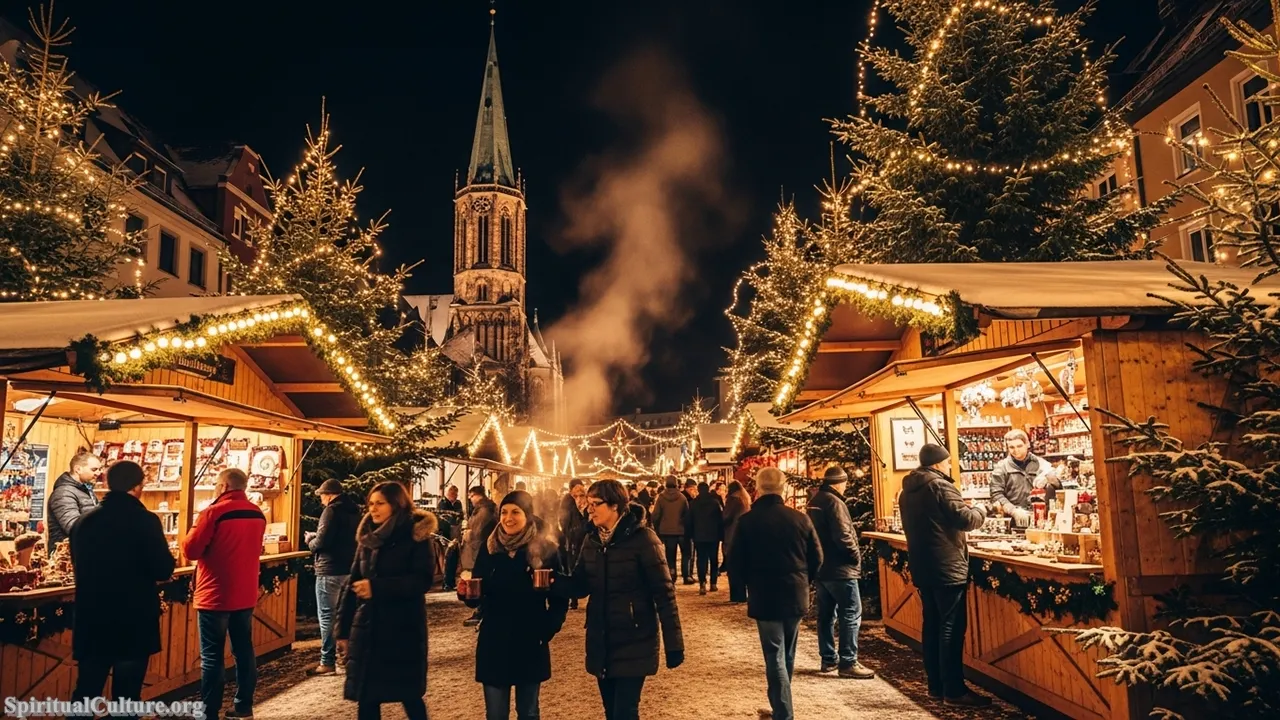The British Isles are a landscape steeped in myth, memory, and an enduring connection to the turning of the seasons. From the misty hills of the Peak District to the rugged coasts of Cornwall, folk traditions serve as a living bridge between the modern world and an ancient, often mysterious past. At Spiritual Culture, we view these events not merely as quirky local customs, but as vital expressions of communal identity and spiritual continuity.
These traditions, ranging from fire festivals that banish the winter darkness to exuberant celebrations of spring fertility, highlight a profound human need to connect with the land and with one another. Many of these practices have survived suppression, industrialization, and modernization, proving the resilience of cultural heritage. They remind us that beneath the surface of contemporary life, the rhythms of our ancestors still beat strongly.
As of the Current Time of Writing, the following list represents the most significant, widely recognized, and spiritually resonant folk traditions in Britain. We have analyzed them based on their historical longevity, the depth of their symbolic meaning, and their ability to bring communities together in a shared sense of wonder and preservation.
Table of the Top 10 British Folk Traditions with the Greatest Cultural Influence
| Rank | Tradition | Primary Location | Seasonal Timing | Core Spiritual/Cultural Value |
|---|---|---|---|---|
| 1 | Summer Solstice at Stonehenge | Wiltshire | Midsummer (June 21st approx) | Cosmic alignment and ancestral reverence |
| 2 | Guy Fawkes Night (Bonfire Night) | Nationwide (Lewes is notable) | November 5th | Community purging and triumph of light |
| 3 | May Day (Jack in the Green) | Hastings / Nationwide | Early May | Rebirth of nature and fertility |
| 4 | Up Helly Aa | Lerwick, Shetland | Last Tuesday in January | Viking heritage and the end of Yule |
| 5 | The Padstow ‘Obby ‘Oss | Padstow, Cornwall | May Day (May 1st) | Primal energy and community unity |
| 6 | Well Dressing | Derbyshire / Peak District | May to September | Gratitude for water and purity |
| 7 | Cooper’s Hill Cheese-Rolling | Brockworth, Gloucester | Spring Bank Holiday | Endurance and the absurdity of play |
| 8 | Apple Wassailing | West Country / Cider Regions | Twelfth Night / Old Twelfth Night | Agricultural blessing and nature communion |
| 9 | Shrove Tuesday (Pancake Day) | Nationwide (Olney is notable) | Day before Ash Wednesday | Feasting and communal preparation |
| 10 | Mummers Plays | Nationwide | Boxing Day / Midwinter | Cycles of death and resurrection |
Top 10. Mummers Plays
Mummers Plays are one of the oldest surviving forms of folk theatre in Britain, traditionally performed during the midwinter season, particularly on Boxing Day. These plays are often impromptu street performances featuring stock characters like Saint George, the Turkish Knight, and the Quack Doctor. The narrative almost always centers on a combat, a death, and a miraculous resurrection brought about by the Doctor, symbolizing the triumph of life over the barrenness of winter.
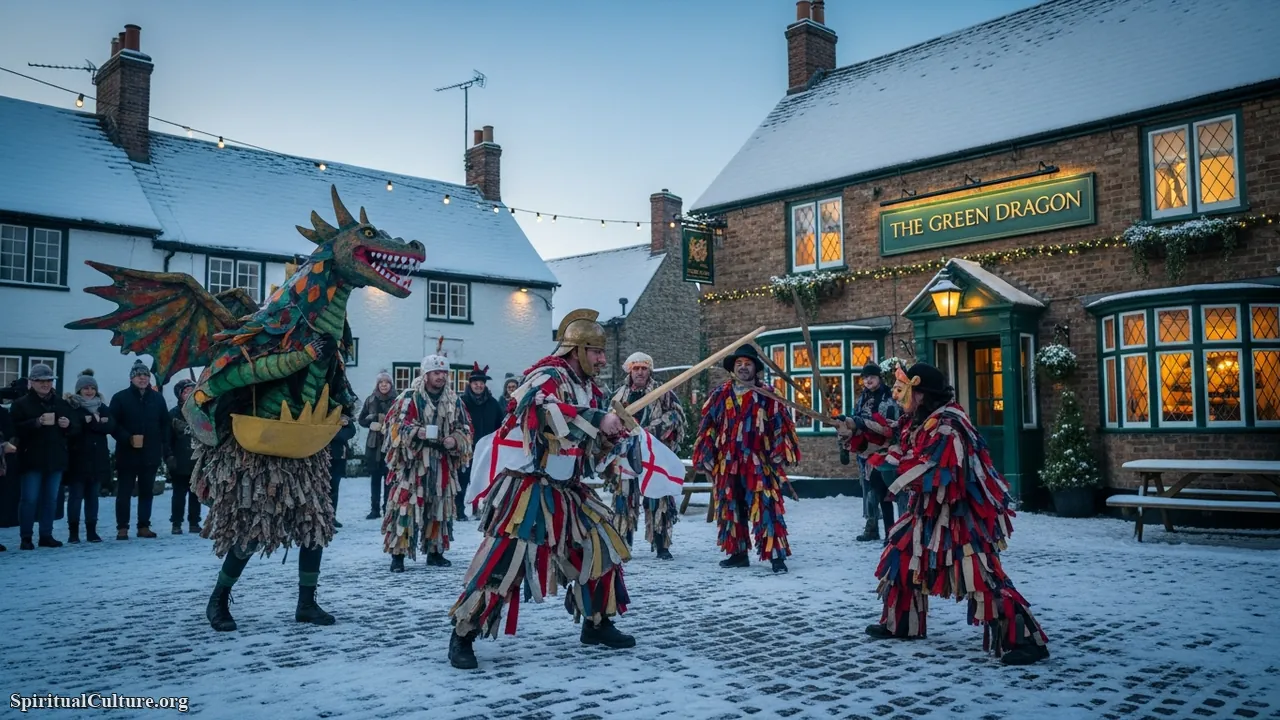
At Spiritual Culture, we recognize the Mummers Play not just as entertainment, but as a ritualistic enactment of the seasonal cycle. The crude rhymes and disguises—often involving strips of paper or rags covering the face—allow the performers to step outside their daily identities and embody archetypal forces. It is a reminder that even in the depth of winter, the seed of life remains, waiting to be revived.
Preserving this tradition is an act of cultural defiance against polished, commercialized entertainment. It maintains the “rough music” of the people, keeping alive a form of storytelling that relies on oral tradition and direct audience interaction. It teaches us that the cycle of life, death, and rebirth is a fundamental truth that must be acknowledged and celebrated annually.
Cultural/Spiritual Highlights:
- Symbolism: Represents the death of the old year and the birth of the new.
- Origins: Roots in medieval mystery plays and pantomime.
- Key Character: The Doctor, who holds the magical power to restore life.
Top 9. Apple Wassailing
Concentrated primarily in the cider-producing regions of the West Country, Apple Wassailing is a raucous and joyous ceremony designed to ensure a good harvest for the coming year. Participants gather in orchards after dark to “wake up” the trees, pouring cider onto the roots and placing toast soaked in cider in the branches as an offering to the robin (a guardian spirit). The ritual involves singing traditional wassail songs and making noise with pots and pans to scare away evil spirits.
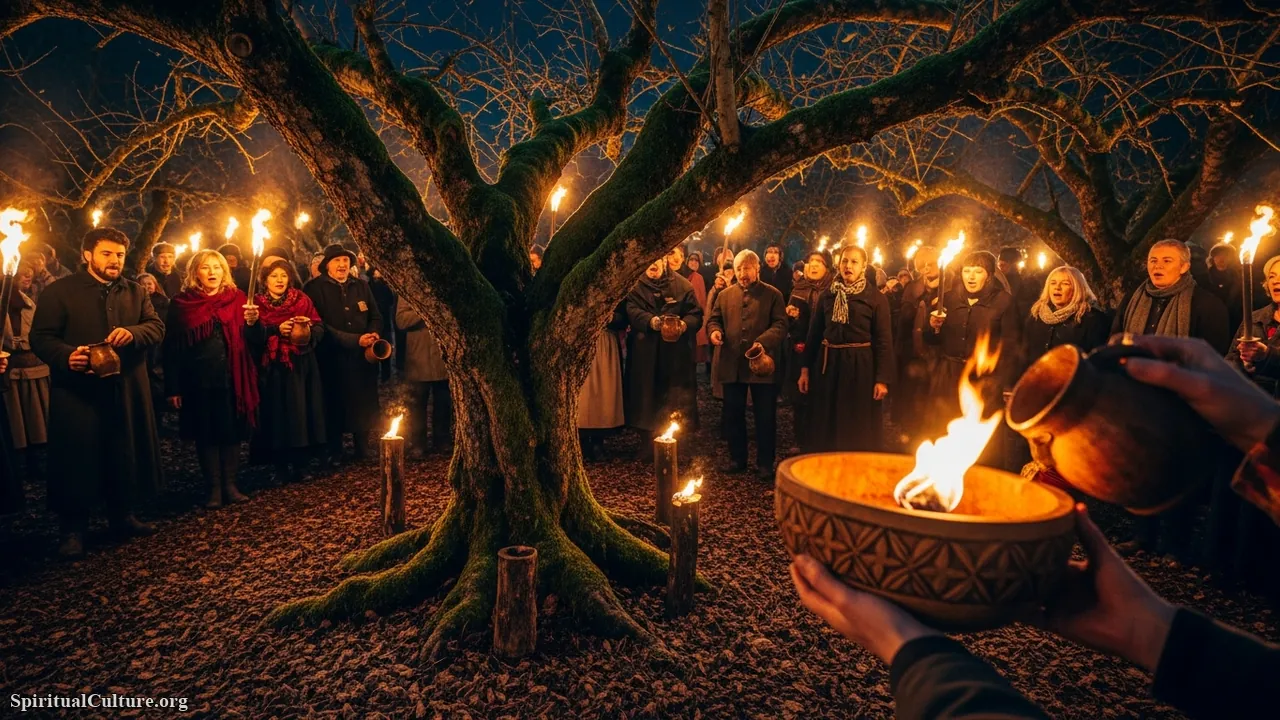
The spiritual impact of Wassailing lies in its recognition of the interdependence between humanity and nature. It is a humble admission that we do not control the earth; rather, we must court its favor and treat it with respect. By blessing the trees, the community acknowledges the source of their sustenance and joy, fostering a relationship of reciprocity rather than exploitation.
In an era of industrial agriculture, Wassailing stands as a vital reminder of the sacredness of food production. It encourages a sense of stewardship and gratitude, reminding us that the land is living and responsive. The communal aspect, sharing the “wassail bowl,” strengthens village bonds and reinforces a collective responsibility for the local environment.
Cultural/Spiritual Highlights:
- Purpose: To bless apple trees and ward off malevolent spirits.
- Ritual Object: The Wassail Bowl, passed around for communal drinking.
- Spiritual Connection: Direct communication with the spirit of the orchard.
Top 8. Shrove Tuesday (Pancake Day)
While now often associated merely with eating pancakes, Shrove Tuesday marks the final day of feasting before the penitential season of Lent. Historically, this was a time for communities to use up rich foods like eggs and fats, which were forbidden during the Lenten fast. The most famous manifestation of this tradition is the Pancake Race in Olney, Buckinghamshire, which dates back to 1445, where local women race while flipping pancakes in a skillet.
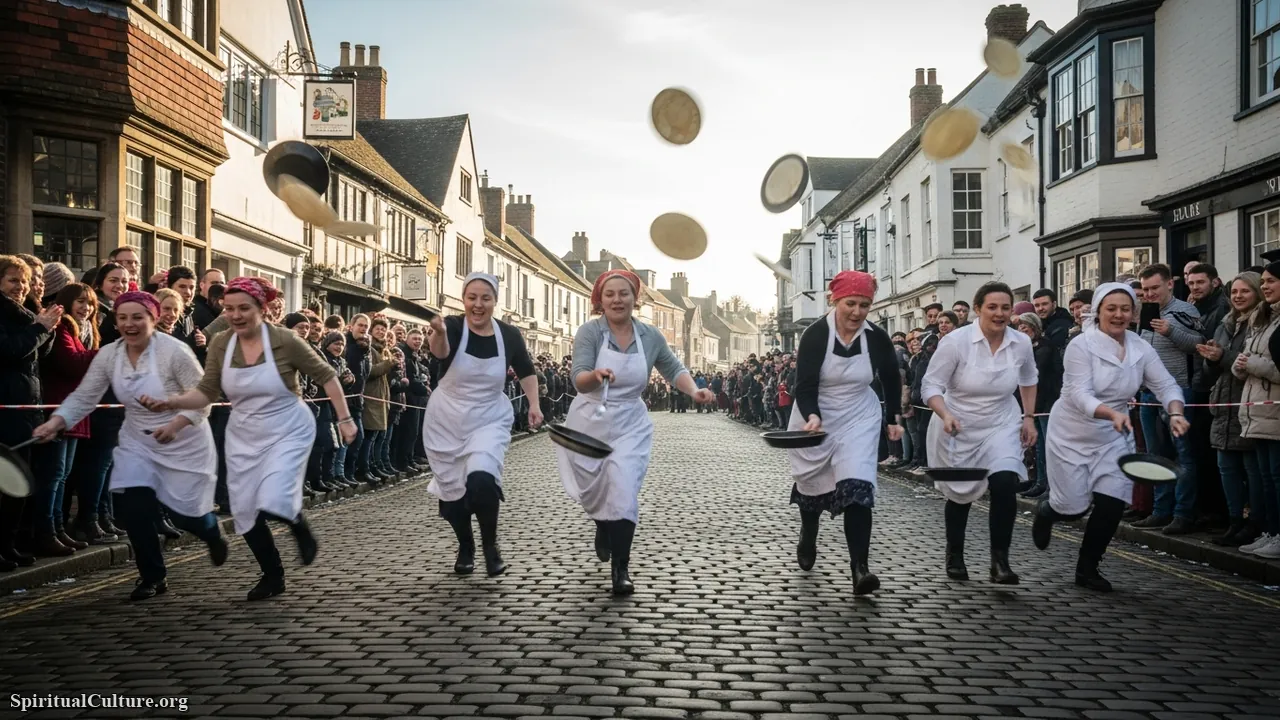
From an analytical perspective, this tradition represents the “carnivalesque”—a brief moment of indulgence and chaos before a period of spiritual discipline. It highlights the balance necessary in the human experience between feasting and fasting, celebration and reflection. The races themselves foster a fierce but friendly local pride, anchoring the community in a shared history that has outlasted centuries of social change.
The preservation of Shrove Tuesday customs keeps the rhythm of the Christian calendar alive in a secular world. It serves as a marker of time, transitioning the community from winter into the spiritual springtime of Easter. It teaches us the value of preparation and the joy of sharing abundance before entering a time of restraint.
Cultural/Spiritual Highlights:
- History: The Olney Pancake Race is one of the world’s oldest continuously running sporting events.
- Significance: The “last hurrah” of community feasting before Lenten discipline.
- Community Value: reinforces local identity through eccentric competition.
Top 7. Cooper’s Hill Cheese-Rolling
Perhaps the most bizarre entry on our list, the Cooper’s Hill Cheese-Rolling and Wake involves participants chasing a Double Gloucester cheese down a near-vertical hill. While it may seem like pure folly, resulting in tumbles and injuries, it is a globally famous event that speaks to the British love for eccentricity and physical endurance. Its origins are debated, with some theories suggesting it relates to maintaining grazing rights or pagan rituals celebrating the turn of summer.
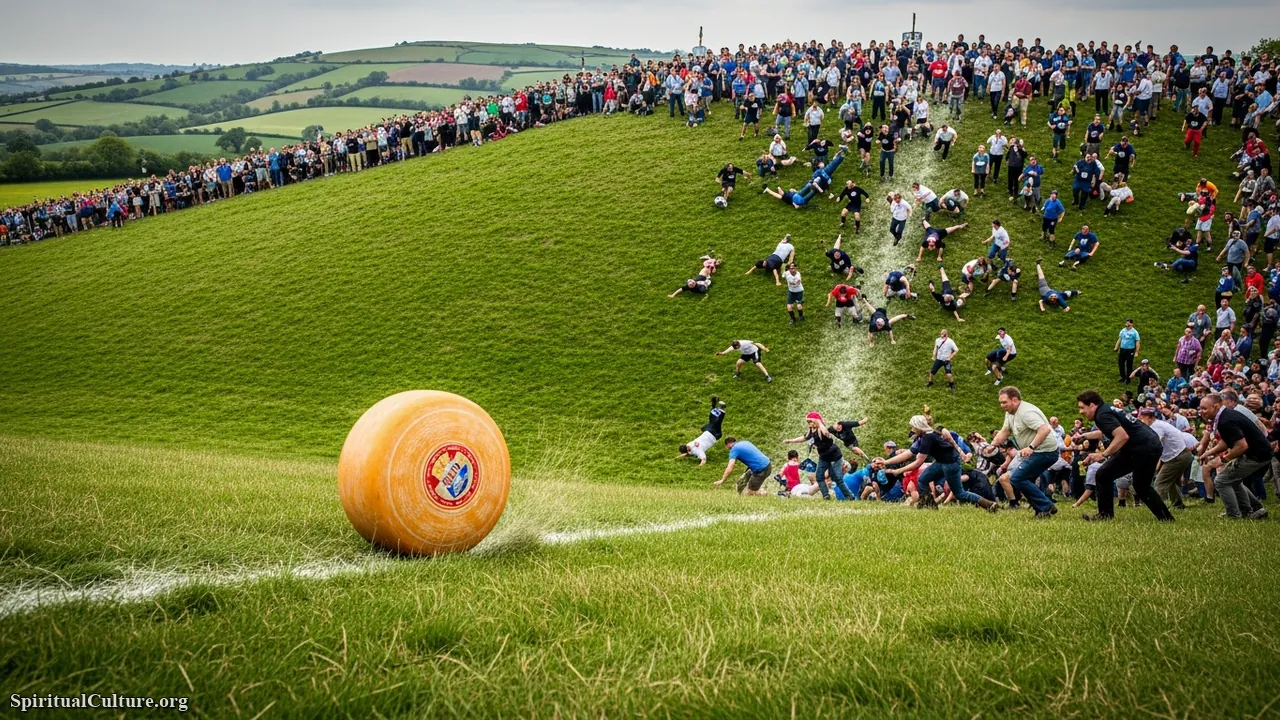
At Spiritual Culture, we interpret this event as a manifestation of the human spirit’s desire to challenge nature and embrace absurdity. In a world that is often overly regulated and risk-averse, the Cheese Rolling is a raw, chaotic release of energy. It is a celebration of bravery (or perhaps foolhardiness) that binds the participants and spectators in a shared experience of adrenaline and spectacle.
The survival of this event, despite numerous health and safety attempts to ban it, demonstrates the power of folk will. It is a testament to the community’s determination to govern their own traditions. It reminds us that play, danger, and tradition are sometimes inextricably linked, offering a necessary release from the structured norms of society.
Cultural/Spiritual Highlights:
- Nature: A test of physical courage against the landscape.
- Legacy: Maintained by local will despite official opposition.
- Symbolism: The circle of the cheese representing the rolling sun or the cycle of the year.
Top 6. Well Dressing
Native to the Peak District and Derbyshire, Well Dressing is a unique and artistic tradition where natural springs and wells are decorated with large panels created from flower petals, seeds, and other natural materials pressed into clay. Dating back potentially to the plague years (as a thanksgiving for pure water) or even earlier pagan water worship, these intricate mosaics are labors of love that take days to create but last only a short time.
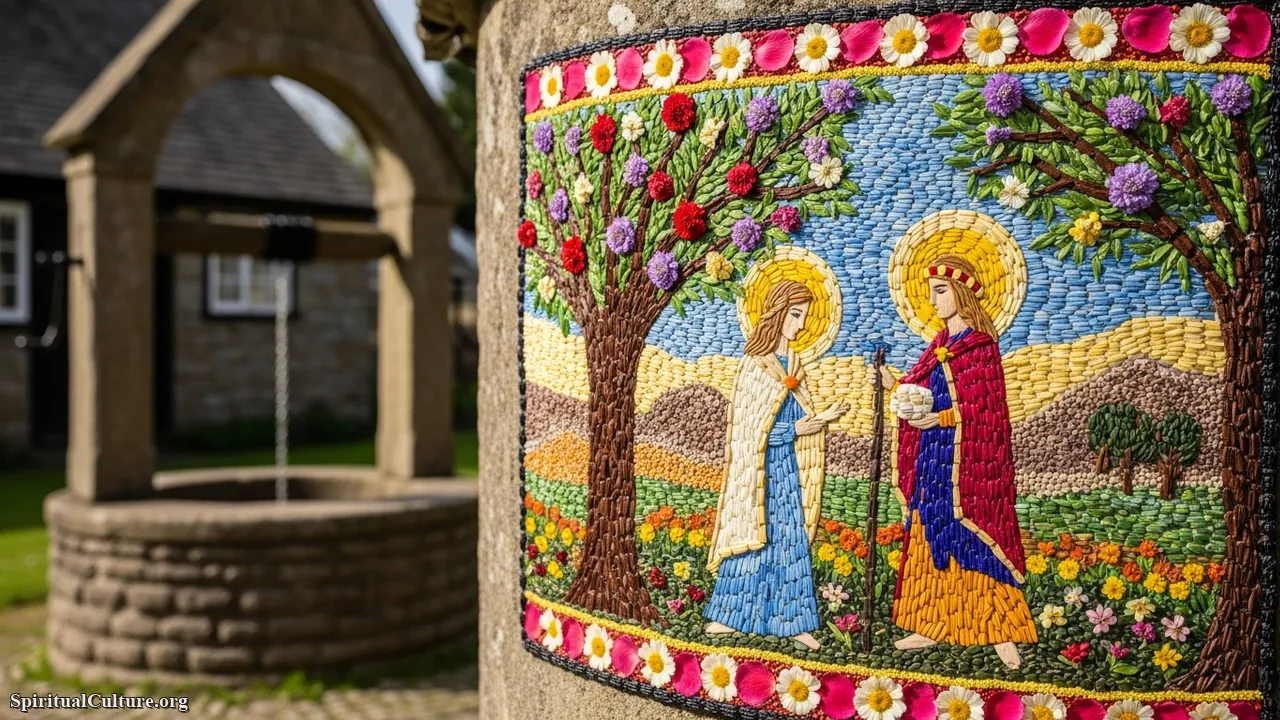
The spiritual profoundness of Well Dressing lies in its act of gratitude for water, the most essential element of life. In a modern world where water is taken for granted, this tradition sanctifies the source. The ephemeral nature of the art—beautiful for a week before decaying back into the earth—serves as a meditation on impermanence and the cycle of nature.
This tradition fosters intense community collaboration, with villages working together to create the designs. It teaches the moral lesson of thankfulness and the beauty of offering one’s labor for a communal good rather than personal gain. It is a quiet, reflective celebration that beautifies the landscape and honors the earth.
Cultural/Spiritual Highlights:
- Technique: “Petalling” creates intricate images using only natural materials.
- Core Value: Reverence for water as a life-giving force.
- Heritage: A distinct regional craft passed down through generations.
Top 5. The Padstow ‘Obby ‘Oss
On May Day, the Cornish town of Padstow comes alive with swirling colors, accordions, and drums for the festival of the ‘Obby ‘Oss (Hobby Horse). Two distinct horses, the “Old Oss” and the “Blue Ribbon Oss,” dance through the streets, capturing “maidens” under their skirts in a symbolic act of fertility. The atmosphere is intense, rhythmic, and primal, drawing thousands of spectators into a trance-like celebration of spring’s arrival.

This tradition is a powerful example of a surviving pre-Christian fertility rite seamlessly woven into modern community life. The “Unite and Unite” song that permeates the day acts as a mantra, binding the townspeople together. Spiritual Culture views the ‘Oss as a vessel for the earth’s energy; its wild dancing represents the uncontrollable, burgeoning force of nature waking up after winter.
The Padstow ‘Obby ‘Oss is not a performance for tourists; it is a rite belonging to the people of Padstow. Its preservation safeguards a deep, visceral connection to the land and ancestral history. It reminds us that beneath our civilized exterior, we are still connected to the wild rhythms of the seasons and the biological imperative of life.
Cultural/Spiritual Highlights:
- Atmosphere: Hypnotic drumming and singing create a communal trance.
- Symbolism: The ‘Oss represents the fertilization and awakening of the earth.
- Uniqueness: One of the oldest and most distinct dance customs in Europe.
Top 4. Up Helly Aa
Held in Lerwick, Shetland, Up Helly Aa is a spectacular fire festival that marks the end of the Yule season. While it celebrates the islands’ Norse heritage, the modern iteration is a Victorian innovation that has become a defining cultural pillar. A torchlit procession of “Guizers,” led by the Guizer Jarl, culminates in the burning of a replica Viking galley, followed by a night of performance and revelry.
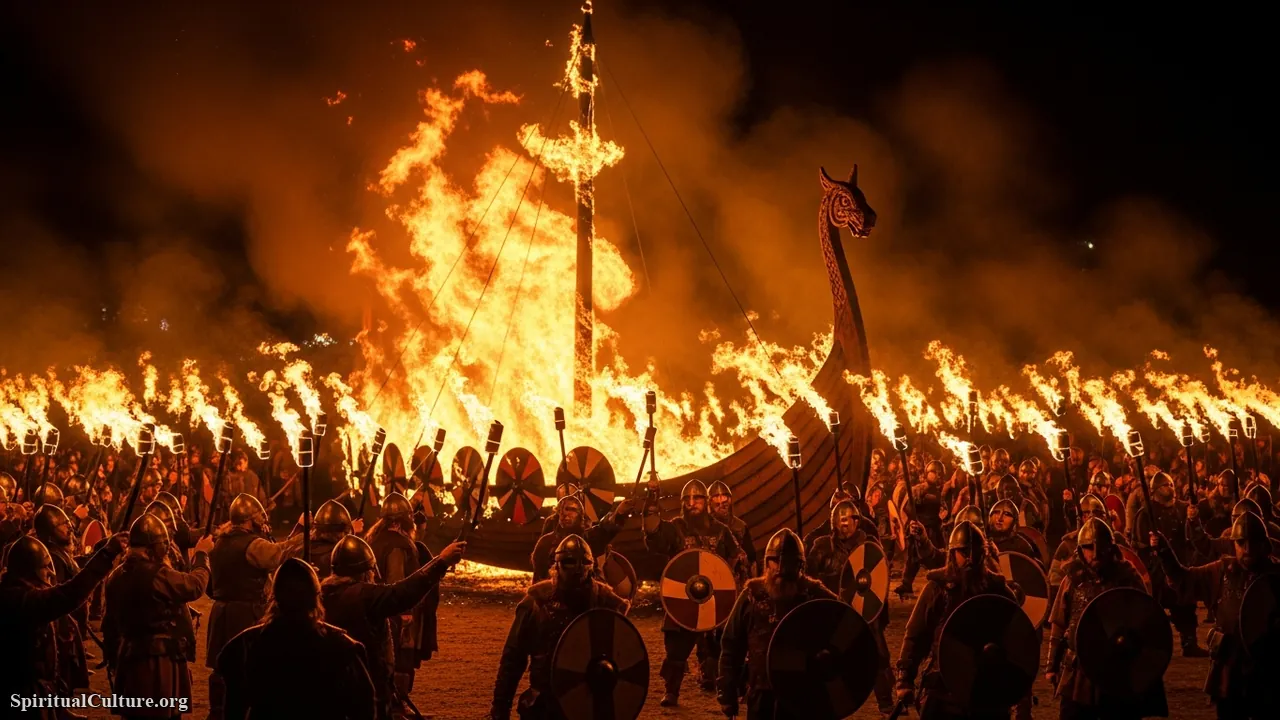
The spiritual impact of Up Helly Aa is found in its mastery of fire and light during the darkest time of the year. It is a defiant assertion of life and warmth against the cold North Atlantic winter. The burning of the galley is a symbolic release—a grand sacrifice that purges the old year and blazes a trail for the returning sun. It strengthens the distinct cultural identity of the Shetlanders, separating them from the mainland UK narrative.
This event requires months of preparation and volunteer work, exemplifying the highest standards of community organization. It teaches the value of collective effort and the importance of honoring one’s specific heritage. It is a celebration of history, not as a dusty textbook, but as a living, burning flame.
Cultural/Spiritual Highlights:
- Spectacle: Europe’s largest fire festival.
- Heritage: Celebrates Shetland’s deep Norse/Viking ancestry.
- Ritual: The burning of the galley symbolizes closure and renewal.
Top 3. May Day (Jack in the Green)
While May Day is celebrated across Britain, the “Jack in the Green” tradition (notably in Hastings and Rochester) is visually the most striking. The “Jack” is a pyramidal framework completely covered in foliage and flowers, paraded through the streets accompanied by Morris dancers, giants, and musicians. Historically, this figure was associated with chimney sweeps, but spiritually, he represents the Green Man—the spirit of the forest and the vegetative soul of nature.
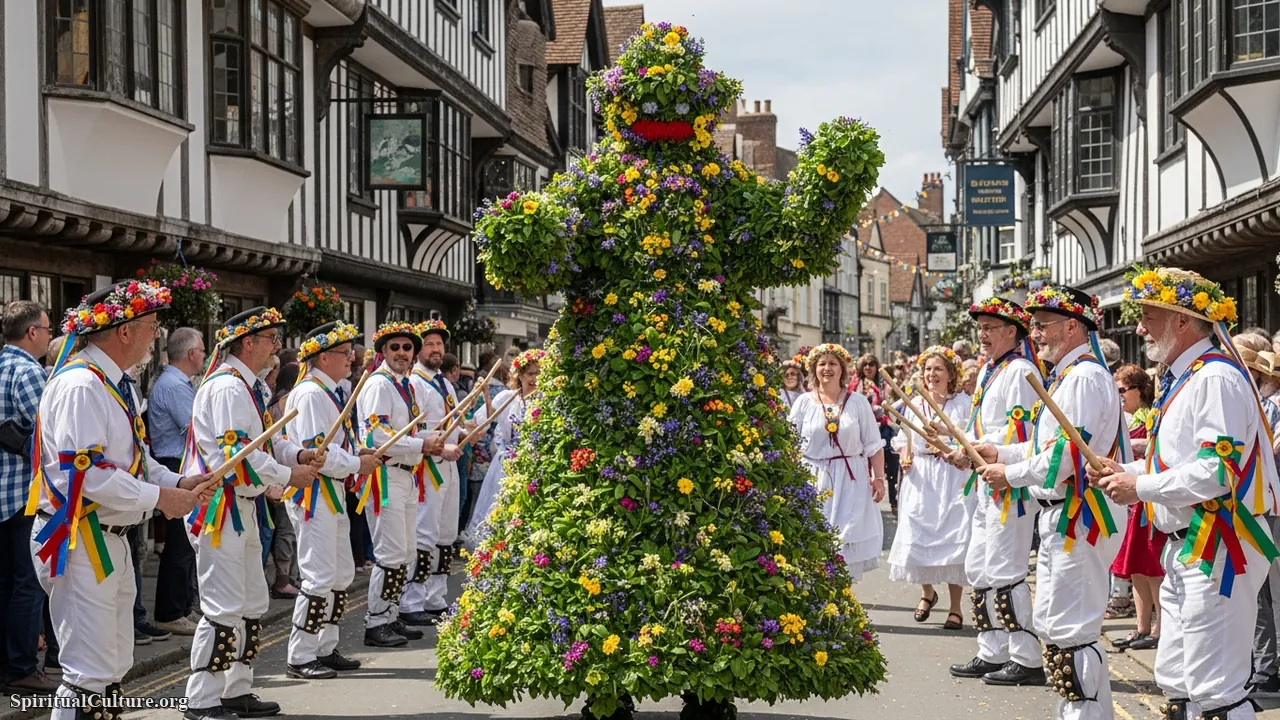
At Spiritual Culture, we see Jack in the Green as the ultimate environmental icon. He is nature personified, walking among the people. The festival releases the “green energy” of spring into the town, blessing the community with vitality. The Morris dancing that accompanies him is an act of rhythmic magic, striking the earth with sticks and jingling bells to wake the soil.
Revived in the late 20th century, this tradition shows the modern hunger for connection with the natural world. It is a joyous rebellion against the grey concrete of urban life, reclaiming the streets for nature, color, and music. It teaches us to welcome the spring not just as a weather change, but as a spiritual renewal of the world.
Cultural/Spiritual Highlights:
- Iconography: The “Jack” is a living bush, a personification of Summer.
- Connection: deeply linked to the archetype of the Green Man.
- Revival: A successful example of resurrected folklore thriving in the modern age.
Top 2. Guy Fawkes Night (Bonfire Night)
On November 5th, the skies of Britain explode with fireworks and the ground glows with bonfires. Ostensibly a commemoration of the foiled Gunpowder Plot of 1605, where Guy Fawkes attempted to blow up Parliament, the event has evolved into a much deeper seasonal ritual. In towns like Lewes, the celebrations take on an intense, almost pagan atmosphere with marching societies and burning effigies.

While the political origins are specific, the spiritual function of Bonfire Night is universal: it is a festival of light and fire as the days shorten. It serves a cathartic function, historically allowing communities to burn effigies of figures representing evil or oppression. It acts as a communal “purging,” using fire to cleanse the community of the year’s accumulated negativity before the deep winter sets in.
This tradition remains one of the few that is celebrated in almost every community, from private backyards to massive public displays. It brings neighbors together in the cold night air, sharing food and warmth. It reminds us of the power of memory—”Remember, remember”—and the collective need to gather around the fire for safety and solidarity.
Cultural/Spiritual Highlights:
- Historical Root: Commemorates the survival of the King and Parliament in 1605.
- Seasonal Role: A fire festival marking the transition into winter.
- Community: A night of collective gathering, noise, and spectacle.
Top 1. Summer Solstice at Stonehenge
The Summer Solstice at Stonehenge is the crown jewel of British spiritual heritage. Thousands of people—druids, pagans, tourists, and locals—gather at the ancient neolithic monument in Wiltshire to watch the sun rise over the Heel Stone on the longest day of the year. This is not merely a folk custom; it is a pilgrimage to one of the world’s most significant prehistoric temples, aligning modern humanity with the cosmos.

The spiritual impact here is unparalleled. Standing among the stones as the sun breaks the horizon connects the participant to ancestors who stood in the exact same spot 4,500 years ago. It is a moment of “communal effervescence,” where the boundaries between time, space, and individual identity dissolve in the face of the solar cycle. It validates the sophisticated understanding our ancestors had of the universe and their dedication to marking its passage.
Spiritual Culture ranks this as Number 1 because it transcends simple tradition to become a profound spiritual experience. It is a testament to the endurance of the human search for meaning. Preserving the sanctity of Stonehenge during the Solstice teaches us humility and awe, reminding us that we are part of a vast, celestial clockwork that has turned long before us and will turn long after we are gone.
Cultural/Spiritual Highlights:
- Alignment: The monument is perfectly engineered to frame the solstice sunrise.
- Global Status: A UNESCO World Heritage site of immense spiritual gravity.
- Experience: A rare opportunity to touch the stones and connect with the Neolithic past.
Conclusion
These Top 10 British Folk Traditions are far more than dates on a calendar; they are the heartbeat of a culture that refuses to forget its origins. From the fiery spectacles of Shetland to the silent majesty of Stonehenge, each entry on this list offers a unique pathway to understanding the spiritual landscape of Britain. They remind us that heritage is not static—it is danced, burned, rolled, and sung into existence year after year.
At Spiritual Culture, we believe that engaging with these traditions offers a remedy to the isolation of modern life. They invite us to step out of our homes, join hands with our neighbors, and participate in rituals that honor the earth and our shared history. As we look to the future, the preservation of these customs ensures that the wisdom, joy, and resilience of our ancestors remain a guiding light.
Whether you are watching a cheese tumble down a hill or waiting for the sun to rise over ancient stones, you are participating in a story that is thousands of years in the making. We encourage you to not just read about these traditions, but to witness them, ensuring their spirit endures for generations to come.
